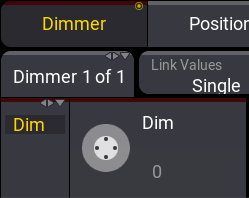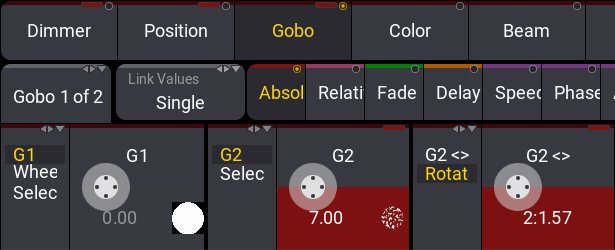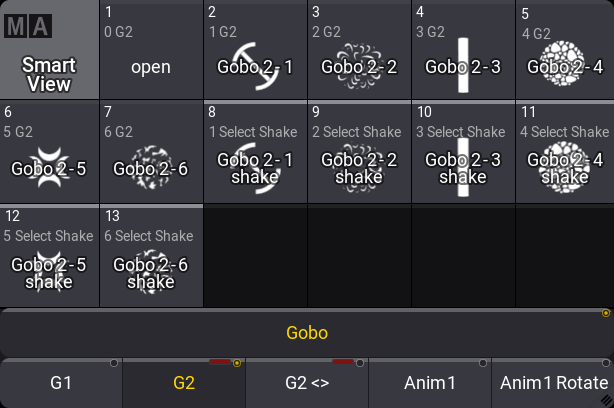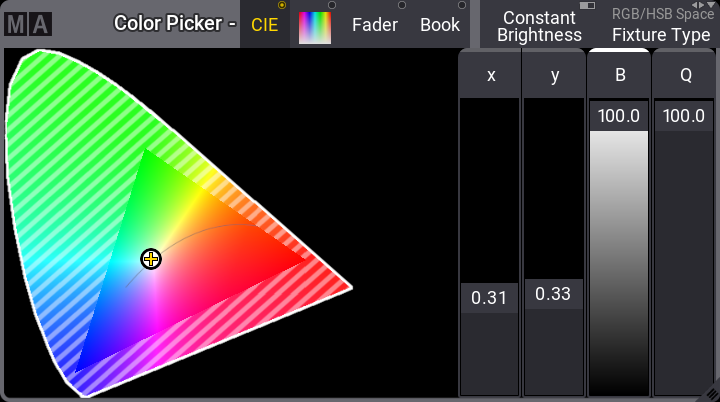- grandMA3 User Manual
- grandMA3 Quick Start Guide
- 00 Welcome
- 01 New Show and Setup
- 02 First Patch
- 03 First View Setup
- 04 Control Simple Fixtures
- 05 3D Fixture Setup
- 06 Groups, Appearances, and Scribbles
- 07 Macros
- 08 Store Cues and Use Executors
- 09 Add Moving Lights
- 10 Presets
- 11 Phasers
- 12 Sequence with multiple cues
- 13 Network and How to Output DMX
- grandMA3 Quick Manual consoles
- grandMA3 Quick Manual processing units
- grandMA3 Quick Manual Nodes
- grandMA3 Quick Manual Nodes DIN-Rail
- grandMA3 Quick Manual onPC command wing XT
- grandMA3 Quick Manual onPC command wing
- grandMA3 Quick Manual onPC fader wing
- grandMA3 Quick Manual onPC rack-unit
- grandMA3 Quick Manual viz-key
- grandMA3 Quick Manual I/O Nodes
- Release Notes
New help version
The help version you selected belongs to an older software version. You may want to view the latest help version.
Add Moving Lights
Table of contents of this topic
In this chapter, we are going to return to the patch and add some moving lights.
We are going to add a variety of fixtures and we are going to hang them on our fixture pods.
You should know how to add the fixtures. If not then please have look at chapter 2 before continuing.
This is a table with the needed fixtures and the information you have to add. Be careful not to add them inside the Blinder grouping fixture.
If the fixture exists in the "grandMA3" library then you should use that fixture. Otherwise, you can use a fixture from the grandMA2 library.
Remember that you have to change the patch menu to show Full columns to see the position columns.
| FID: | Name: | Type: | Patch: | X-Pos: | Y-Pos: | Z-Pos: |
|---|---|---|---|---|---|---|
| 101 | X4 Bar 1 | Impression X4 BAR 20 - Single Pixel High Resolution Mode (89 Ch) | 2.1 | -1.5 | 0.5 | 4.5 |
| 102 | X4 Bar 2 | Impression X4 BAR 20 - Single Pixel High Resolution Mode (89 Ch) | 2.90 | 1.5 | 0.5 | 4.5 |
| 103 | X4 Bar 3 | Impression X4 BAR 20 - Single Pixel High Resolution Mode (89 Ch) | 2.179 | -3.0 | 2.1 | 4.0 |
| 104 | X4 Bar 4 | Impression X4 BAR 20 - Single Pixel High Resolution Mode (89 Ch) | 2.268 | 0.0 | 2.1 | 4.0 |
| 105 | X4 Bar 5 | Impression X4 BAR 20 - Single Pixel High Resolution Mode (89 Ch) | 2.357 | 3.0 | 2.1 | 4.0 |
| 106 | X4 Bar 6 | Impression X4 BAR 20 - Single Pixel High Resolution Mode (89 Ch) | 3.1 | -1.5 | 3.6 | 3.5 |
| 107 | X4 Bar 7 | Impression X4 BAR 20 - Single Pixel High Resolution Mode (89 Ch) | 3.90 | 1.5 | 3.6 | 3.5 |
| 201 | Mythos 1 | Mythos - Standard | 4.1 | -1.5 | 0.8 | 4.5 |
| 202 | Mythos 2 | Mythos - Standard | 4.31 | 1.5 | 0.8 | 4.5 |
| 203 | Mythos 3 | Mythos - Standard | 4.61 | -3.0 | 2.4 | 4.0 |
| 204 | Mythos 4 | Mythos - Standard | 4.91 | 0.0 | 2.4 | 4.0 |
| 205 | Mythos 5 | Mythos - Standard | 4.121 | 3.0 | 2.4 | 4.0 |
| 206 | Mythos 6 | Mythos - Standard | 4.151 | -1.5 | 3.9 | 3.5 |
| 207 | Mythos 7 | Mythos - Standard | 4.181 | 1.5 | 3.9 | 3.5 |
| 301 | AuraXB 1 | Mac Aura XB - Standard (14 ch) | 5.1 | -1.0 | 0.8 | 4.5 |
| 302 | AuraXB 2 | Mac Aura XB - Standard (14 ch) | 5.15 | 2.0 | 0.8 | 4.5 |
| 303 | AuraXB 3 | Mac Aura XB - Standard (14 ch) | 5.29 | -2.5 | 2.4 | 4.0 |
| 304 | AuraXB 4 | Mac Aura XB - Standard (14 ch) | 5.43 | 0.5 | 2.4 | 4.0 |
| 305 | AuraXB 5 | Mac Aura XB - Standard (14 ch) | 5.57 | 3.5 | 2.4 | 4.0 |
| 306 | AuraXB 6 | Mac Aura XB - Standard (14 ch) | 5.71 | -1.0 | 3.9 | 3.5 |
| 307 | AuraXB 7 | Mac Aura XB - Standard (14 ch) | 5.85 | 2.0 | 3.9 | 3.5 |
| 401 | Sharpy 1 | Sharpy - Standard Lamp On | 6.1 | -2.0 | 0.8 | 4.5 |
| 402 | Sharpy 2 | Sharpy - Standard Lamp On | 6.17 | 1.0 | 0.8 | 4.5 |
| 403 | Sharpy 3 | Sharpy - Standard Lamp On | 6.33 | -3.5 | 2.4 | 4.0 |
| 404 | Sharpy 4 | Sharpy - Standard Lamp On | 6.49 | -0.5 | 2.4 | 4.0 |
| 405 | Sharpy 5 | Sharpy - Standard Lamp On | 6.65 | 2.5 | 2.4 | 4.0 |
| 406 | Sharpy 6 | Sharpy - Standard Lamp On | 6.81 | -2.0 | 3.9 | 3.5 |
| 407 | Sharpy 7 | Sharpy - Standard Lamp On | 6.97 | 1.0 | 3.9 | 3.5 |
Exit the patch and save the new setup.
Create new Groups
Create the following groups:
| Group No.: | Group Name: | Fixtures: |
|---|---|---|
| 6 | All X4 Bar | 101 Thru 107 |
| 7 | All Mythos | 201 Thru 207 |
| 8 | All Aura | 301 Thru 307 |
| 9 | All Sharpy | 401 Thru 407 |
| 10 | Pod 1 | 21 + 22 + 101 + 201 + 301 + 401 |
| 11 | Pod 2 | 23 + 24 + 102 + 202 + 302 + 402 |
| 12 | Pod 3 | 25 + 26 + 103 + 203 + 303 + 403 |
| 13 | Pod 4 | 27 + 28 + 104 + 204 + 304 + 404 |
| 14 | Pod 5 | 29 + 30 + 105 + 205 + 306 + 406 |
| 15 | Pod 6 | 31 + 32 + 106 + 206 + 306 + 406 |
| 16 | Pod 7 | 33 + 34 + 107 + 207 + 307 + 407 |
You can create and assign appearances to the groups if you like.
Fixture Sheet Version 2
We are going to need another version of the fixture sheet.
The first we made shows the intensity attributes.
We need a new one where we can see all the other attributes.
Create a new fixture sheet.
Let us adjust some of the sheet settings. Tap the MA icon in the upper left corner of the sheet.
Make sure both 'Fixture Sort' and 'Feature Sort' is On and that the 'Sheet Mode' is set to Fixture.
That is it for now. Please close the settings.
Store this as a new view.
Controlling Moving Lights
In the previous chapters, we have looked at controlling the dimmer attribute. But now we have many more attributes.
The key to controlling these attributes is the Feature Group Control Bar.

With this, you can control what feature group you are controlling with the encoders.
All fixtures are separated into different sections. These are called feature groups.
The bar will display the feature groups you have access to.
If you select fixture 101 (or group 6), then the bar above each button might change (from gray to red). This indicates the feature groups you can use for the selected fixture. If you clear your programmer and try to select fixture 1, then you can see that it is only the 'Dimmer' button that got a red bar.
Selecting a feature group also selects the feature and the encoders give access to the first attributes in the feature.
Fixtures are structured in a hierarchy. The attributes are organized inside features and features are organized inside feature groups.
The image below shows the dimmer feature group is selected. Below this is a button showing the feature (the button says "Dimmer 1 of 1"). Below the feature, there is the first encoder controlling the first attribute (Dim) in the dimmer feature.

There can be several encoder pages for a feature. That is why the feature button says "1 of 1", it is page one of one page. We need a second page if a feature has more attributes than we have encoders.
To get a better feeling for controlling fixtures we should try the different elements of the Mythos. Clear your programmer and select group 7.
Dimmer
You can assign a dimmer value using the methods you learned in the previous chapters or you can select the Dimmer feature group by touching the bar and turn the left encoder to turn up the lights. Please turn the fixture at full.
Position
Select Position by tapping it in the bar. Notice how your encoder changes function according to what feature group you have selected. With the "Position", your encoders look like this:

Turning the encoders changes the values. Turning them with the encoder pressed changes the value faster.
The outer ring on the dual encoders cannot be pressed. Pressing the small key next to the outer ring is equal to pressing the ring.
If you want to make smaller movements with a turn (increasing the resolution) you can press and hold the MA button and select a different resolution. On the grandMA3 onPC, you need to open the command section (F3) and click and hold the MA button and slide the mouse out of the button and then release the mouse button to latch the MA button.
This changes the small area next to the encoder readout.

Tapping this area changes between four different resolutions for the encoder. The icon inside the encoder changes to show the selected resolution.
Try to change the resolution and move the fixture using the encoder.
Notice that the Dimmer and Position buttons in the feature group control bar have a red marker. This indicates that you have active programmer values in that feature group.
Gobo
Gobos can be added if the fixtures contain the attributes.
The fixture is designed by the manufacturer to control the gobo in different ways. Some manufacturers have a lot of functions on the same DMX channels and others spread the functions out on different DMX channels. The Mythos has two gobo wheels with different gobos. The first wheel is physically a single metal plate with different cutouts. We can choose what cutout to have in from of the light. And the wheel can spin continually.
The second gobo wheel is a wheel with replaceable gobos that can be indexed and rotated.
Let us give the second wheel a try.
Tap Gobo in the feature group control bar.
Now we have the gobo controls on the encoders. The first encoder is "G1" - this is gobo wheel one.
The second encoder is used to select a gobo on the second gobo wheel. Gobos are often defined in the fixture type definition and the gobos in the different "wheel slots" are often defined. These definitions include small images that match the actual gobos in the fixture.
Try to shortly press the second encoder (click on the value area of the encoder label). This opens the calculator that we talked about in chapter 4.
Around the middle of the calculator, there is a button called 'Channel Sets'. Please click this.
Now the right side displays the defined gobos on the second wheel.

When an encoder controls different functions, then they can be separated into different groups of values. At the top of the calculator, there are two taps. The second tap can be used to select the same gobos but with a gobo shake mode.
Select one of the gobos in the non-shake mode.
The third encoder controls the rotation of the selected gobo on gobo wheel 2. This encoder also has two different modes. They are index (G2<>) and continuous rotation (Rotate). We can change the mode by clicking the area on the left of the encoder label. We also need to give it a value after the mode selection before the fixture does what we want.

Try the different rotation and index functions. Remember you can see the result in the 3D window.
A very good tool with fixtures that have defined Channel Sets like the gobos is the Smart View window. This can be created on an empty user-defined area. It can be found in the More tab in the Add Window pop-up.

This gives access to the defined channel sets by a dynamic pool that changes content based on the selected feature ("Gobo" is the feature in the example above).
Notice that the gobos appear twice. Once for each mode.
Color
Let us have a look at the colors.
The three first encoders control red, green, and blue. This does not match the physical properties of what is inside the Mythos (it has a subtractive color system).
The grandMA3 system has a color engine that gives us the same unified control no matter what color system the fixtures use. This means that we control the Mythos and the Auras using the exact same controls.
We could of course use the encoders to change the colors, but we have a better tool. It is called Color Picker and it is a window that can be created like any other window. It is found in the Common tab.

The color picker has four different modes. The first one we see is the CIE. The modes can be changed in the title bar.
CIE is a CIE 1931 chromaticity diagram. The crossed-out area is the area the selected fixture cannot output. The area changes if we had fixtures with more color options (for instance fixtures with LED emitters of more than the standard red, green, and blue types) or if the fixtures are measured against their real emitters.
A color can be selected by clicking in the color area.
The next mode is called HSB and is represented by a colored square. This can also be clicked to select a color.
The Fader mode gives access to different faders that can be used to select the desired color.
Finally, the Book mode can be used to select different defined filters sorted by manufacturers. The book can be searched by filter name or number. Selecting a filter gives a color that is as close as possible.
The color picker only affects the color mixing system in a fixture. This means that it does not change the color wheels in fixtures. We have patched some Sharpys and they only have a color wheel. If we want to change colors in a Sharpy then it works much like the gobo control and the best tool can be the Smart View window.
The color wheels (C1, C2, etc.) are maybe on a different feature page. So you might need to change the page by clicking the feature button to have access to these functions on the encoders.
Try the different color modes of the color picker and play around with the on-screen faders in the color picker. The "Q" fader is about the color quality and it becomes relevant in RGB+ LED fixtures, where there are different ways to reach the same colors using different sets of LEDs.
Beam
The beam feature group has controls for shutters, iris, prism, and other beam effects. The mythos has some prisms and the 3D can visualize these. On feature page 2 there is a "Prism 1 Pos" attribute. This can be used to rotate the prisms. The combination of a rotating gobo and a rotating prism can give some very interesting looks.
Focus
The focus feature group obviously has controls for the focus. But it also has the zoom attribute.
Zoom is visualized in the 3D window.
Control
The final feature group we have with the patched fixtures is the Control. This is where we find attributes that are used to reset and set different modes in the fixtures. These are often attributes that we do not store in cues. The exception is possibly a sequence that can be used to turn the lamp on and off in the fixtures.
Recap
In this chapter, we have added moving light fixtures to our stage and we have looked at controlling these fixtures.
There is an entire section in the manual about operating fixtures. It gives more details of the different elements we discussed in this chapter.
The next chapter is about Presets.


